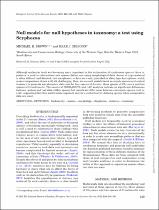| dc.contributor.author | Brown, Michael K. | |
| dc.contributor.author | Gibbons, Mark J. | |
| dc.date.accessioned | 2023-02-13T10:49:56Z | |
| dc.date.available | 2023-02-13T10:49:56Z | |
| dc.date.issued | 2021 | |
| dc.identifier.citation | Brown, M. K., & Gibbons, M. J. (2021). Null models for null hypotheses in taxonomy: A test using Scyphozoa. Biological Journal of the Linnean Society, 134 (1), 240-245. https://doi.org/10.1093/biolinnean/blab070 | en_US |
| dc.identifier.issn | 1095-8312 | |
| dc.identifier.uri | https://doi.org/10.1093/biolinnean/blab070 | |
| dc.identifier.uri | http://hdl.handle.net/10566/8421 | |
| dc.description.abstract | Although molecular tools are becoming more important in the delineation of scyphozoan species there is,
perforce, a need to substantiate new species definitions using morphological data. Access to type material
is often difficult and detailed, raw morphometric data are rarely provided in older type descriptions, which
makes comparisons of new with old challenging. Here, we use null models based on simple measures of central
tendency to generate morphometric data sets for four species of Aurelia, three species of Chrysaora and two
species of Crambionella. The results of PERMANOVA and CAP analyses indicate no significant differences
between random and real data within species, but significant differences between congeneric species (null or
real), suggesting that this multivariate approach may be a useful tool for defining species when comparative
data are scant. | en_US |
| dc.language.iso | en | en_US |
| dc.publisher | Oxford University Press | en_US |
| dc.subject | Biodiversity | en_US |
| dc.subject | Marine | en_US |
| dc.subject | Morphology | en_US |
| dc.subject | Taxonomy | en_US |
| dc.subject | Scyphozoa | en_US |
| dc.title | Null models for null hypotheses in taxonomy: A test using Scyphozoa | en_US |
| dc.type | Article | en_US |

